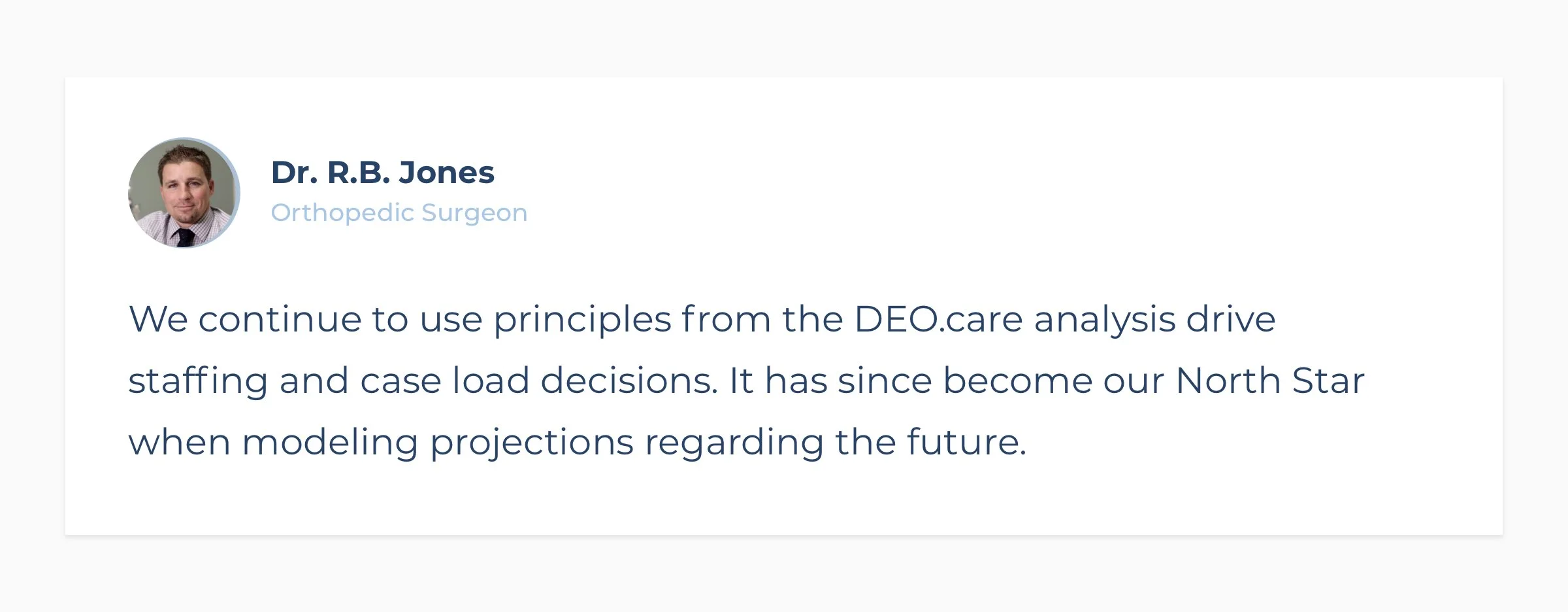From insight to impact: Dr R.B. Jones on achieving lasting OR efficiency
When DEO.care first partnered with Dr. R.B. Jones, it was clear he was already operating at a high level of efficiency and precision. Known for his commitment to value-based care and for using his OR time responsibly to deliver the best outcomes, Dr. Jones wanted to see how data could take an already well-run process to the next level.
Using DEO.care’s digital twin analysis, the team mapped every phase of his total joint workflow and identified his process baseline. The findings confirmed the efficient process already in place and excellent team collaboration. At the same time, the digital twin simulation revealed a clear opportunity: by performing more activities in parallel, the team could reduce idle time, smooth transitions, and add two more cases per day without increasing workload.
At the time of measurement, Dr. Jones was performing 11 cases a day across two rooms. Today, he and his team consistently perform 12–13 cases a day, completing over 1,300 joints a year—a record for his practice and institution.
We spoke with Dr. Jones about how DEO.care’s analysis helped his team turn data into meaningful, lasting improvement.
What was most valuable to you about the DEO.care analysis?
Dr. Jones: The granularity of the data was extremely valuable. It gave us a clear baseline to start from and showed us exactly where we were spending time. You can’t improve what you don’t measure, and this helped us see how every role and transition fit into the bigger picture.
Was there anything surprising in the findings?
Dr. Jones: The benchmarking was inspirational. We were already doing a lot of things well, but the simulation showed how much more we could achieve by shifting from sequential to parallel activity. It wasn’t about working faster—it was about working smarter, reducing the waiting that happens between steps.
What kind of impact did this change have on your team and the hospital?
Dr. Jones: The results were eye-opening for everyone—surgeons, anesthesia, administration. It wasn’t that long ago that 8–9 cases a day was a big deal. The DEO.care report proved that we could do better. It became a tie-breaker in a lot of internal conversations because it showed, with data, that our system could support more throughput without adding stress.
How did this data influence decisions beyond the OR?
Dr. Jones: The report brought alignment across the whole hospital. Our institutional metric is output per room per day, and now we’re using those insights to guide staffing and scheduling. It’s also shaped how we plan for the future.
What message would you share with other teams looking to improve efficiency?
Dr. Jones: Not everyone has to be as fast, but everyone can start from their own baseline and work toward better. The key is seeing where you are, finding the low-hanging fruit, and improving in small, incremental steps. Efficiency doesn’t mean moving quicker—it means reducing waste in the process.
Dr. Jones’ story is a testament to the power of a growth mindset in healthcare. By embracing data as a tool—not a judgment—he and his team were able to challenge assumptions, find opportunities, and continuously refine their processes.
Their achievements were not just the result of individual effort, but of a collaborative culture, where surgeons, anesthesiologists, nurses, and administrators aligned around shared goals.
Together, they demonstrate that with clear insights, open communication, and a willingness to evolve, even the most high-performing teams can reach new heights of efficiency and patient care.

